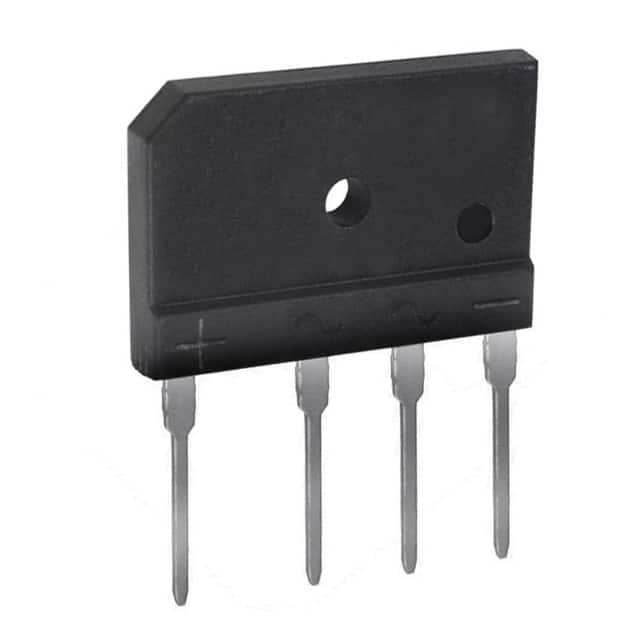GBJ1006-F Product Overview
Introduction
The GBJ1006-F is a semiconductor product belonging to the category of bridge rectifiers. This entry provides an overview of its basic information, specifications, pin configuration, functional features, advantages and disadvantages, working principles, application field plans, and alternative models.
Basic Information Overview
- Category: Bridge Rectifiers
- Use: Converting alternating current (AC) to direct current (DC)
- Characteristics: High efficiency, low power loss, compact design
- Package: Through Hole
- Essence: Efficient AC to DC conversion
- Packaging/Quantity: Typically packaged in reels or tubes, quantity varies by manufacturer
Specifications
- Maximum Average Forward Current: 10A
- Peak Repetitive Reverse Voltage: 600V
- Operating Temperature Range: -55°C to +150°C
- Storage Temperature Range: -55°C to +150°C
- Mounting Type: Through Hole
- Package / Case: GBJ
- Diode Type: Single Phase
Detailed Pin Configuration
The GBJ1006-F bridge rectifier typically consists of four pins arranged in a specific configuration. The detailed pin configuration is as follows: 1. Pin 1: AC Input + 2. Pin 2: AC Input - 3. Pin 3: DC Output + 4. Pin 4: DC Output -
Functional Features
- Efficiently converts AC to DC
- Low power loss
- Compact design for space-saving applications
- Reliable performance under specified operating conditions
Advantages and Disadvantages
Advantages
- High efficiency
- Low power loss
- Compact design
- Reliable performance
Disadvantages
- Not suitable for high voltage applications
- Limited maximum average forward current
Working Principles
The GBJ1006-F bridge rectifier operates on the principle of converting the input AC voltage into a pulsating DC output through a series of diodes and a bridge configuration. When the input AC voltage is applied, the diodes conduct in a specific sequence, resulting in a unidirectional flow of current in the output circuit.
Detailed Application Field Plans
The GBJ1006-F bridge rectifier finds extensive application in various electronic devices and systems, including but not limited to: - Power supplies - Battery chargers - Motor drives - LED lighting systems - Audio amplifiers
Detailed and Complete Alternative Models
- GBJ1004-F: Similar specifications with lower maximum average forward current
- GBJ1008-F: Similar specifications with higher maximum average forward current
- GBJ1010-F: Similar specifications with higher peak repetitive reverse voltage
In conclusion, the GBJ1006-F bridge rectifier offers efficient AC to DC conversion with high reliability and compact design, making it suitable for diverse electronic applications.
Word Count: 410
Senaraikan 10 soalan dan jawapan biasa yang berkaitan dengan aplikasi GBJ1006-F dalam penyelesaian teknikal
What is GBJ1006-F?
- GBJ1006-F is a high-performance semiconductor diode bridge rectifier that is commonly used in power supply and motor control applications.
What are the key features of GBJ1006-F?
- The key features of GBJ1006-F include a high surge current capability, low forward voltage drop, and high reliability.
What are the typical applications of GBJ1006-F?
- GBJ1006-F is commonly used in AC/DC converters, DC power supplies, and motor drives.
What is the maximum forward voltage drop of GBJ1006-F?
- The maximum forward voltage drop of GBJ1006-F is typically around 1 volt at the rated current.
What is the maximum reverse voltage rating of GBJ1006-F?
- The maximum reverse voltage rating of GBJ1006-F is typically around 600 volts.
What is the operating temperature range of GBJ1006-F?
- GBJ1006-F is designed to operate within a temperature range of -55°C to 150°C.
Does GBJ1006-F require a heat sink for certain applications?
- Yes, for high-power applications or when operating at elevated temperatures, a heat sink may be required to ensure proper thermal management.
What are the recommended mounting and soldering techniques for GBJ1006-F?
- GBJ1006-F can be mounted using standard through-hole or surface mount techniques, and it is recommended to follow the manufacturer's guidelines for soldering.
Is GBJ1006-F RoHS compliant?
- Yes, GBJ1006-F is typically RoHS compliant, but it's important to verify with the manufacturer for the latest compliance information.
Are there any common failure modes associated with GBJ1006-F?
- Common failure modes for GBJ1006-F include overcurrent conditions, excessive temperature, and voltage transients, so proper circuit protection measures should be implemented.


